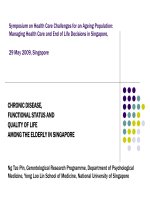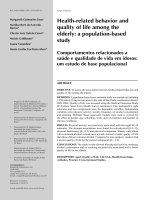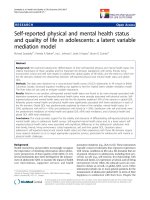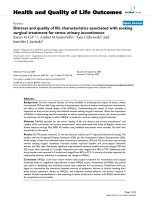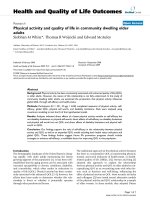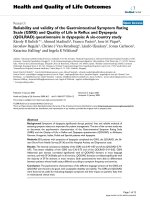Emotional labor, employee engagement and quality of life a research on service employees
Bạn đang xem bản rút gọn của tài liệu. Xem và tải ngay bản đầy đủ của tài liệu tại đây (1.77 MB, 71 trang )
UNIVERSITY OF ECONOMICS HO CHI MINH CITY
International School of Business
------------------------------
HA THI TRUC MAI
EMOTIONAL LABOR, EMPLOYEE
ENGAGEMENT AND QUALITY OF LIFE:
A RESEARCH ON SERVICE EMPLOYEES
MASTER OF BUSINESS (HONOURS)
Ho Chi Minh City – Year 2018
UNIVERSITY OF ECONOMICS HO CHI MINH CITY
International School of Business
------------------------------
HA THI TRUC MAI
EMOTIONAL LABOR, EMPLOYEE
ENGAGEMENT AND QUALITY OF LIFE:
A RESEARCH ON SERVICE EMPLOYEES
MASTER OF BUSINESS (HONOURS)
SUPERVISOR: DR. NGUYEN THI MAI TRANG
Ho Chi Minh City – Year 2018
Table of Contents
List of acronyms .................................................................................................................. 3
List of figure ........................................................................................................................ 4
List of table .......................................................................................................................... 5
Acknowledgement ............................................................................................................... 6
Abstract ................................................................................................................................ 7
Introduction ......................................................................................................................... 8
Theoretical background and Hypothesis development ..................................................... 11
Emotional labor .............................................................................................................. 11
Employee engagement ................................................................................................... 13
Emotional labor and employee engagement .................................................................. 14
Employee engagement and quality of life...................................................................... 16
Moderating effects of work life balance perception ...................................................... 18
Moderating effects of customer orientation ................................................................... 20
Methodology...................................................................................................................... 22
Procedure and sample .................................................................................................... 22
Pilot study....................................................................................................................... 23
Main survey .................................................................................................................... 24
Measurement .................................................................................................................. 25
Data analysis and results.................................................................................................... 26
Sample profile ................................................................................................................ 26
Cronbach’s alpha results ................................................................................................ 27
1
Exploratory Factor Analysis (EFA) results .................................................................... 28
Confirmatory Factor Analysis (CFA) results ................................................................. 28
Hypothesis Testing Results ............................................................................................ 31
Moderating Testing Results ............................................................................................... 32
Discussion .......................................................................................................................... 34
Implications ....................................................................................................................... 35
Theoretical implications ................................................................................................. 35
Managerial implication .................................................................................................. 36
Limitation and direction for future research ...................................................................... 38
Conclusion ......................................................................................................................... 39
References ......................................................................................................................... 40
Appendix 1: Guideline for Pilot study (qualitative in-depth interview) ........................... 46
Appendix 2: Vietnamese questionnaire ............................................................................. 49
Appedix 3: Descriptive statistic of sample ........................................................................ 51
Appendix 4: The results of Cronbach’s alpha coefficient of reliability ............................ 54
Appendix 5. EFA Results .................................................................................................. 58
Appendix 6. CFA results for model .................................................................................. 60
Appendix 7: Structural results for model .......................................................................... 65
Appendix 8: Moderating testing results ............................................................................ 68
Appendix 9: The answer of interviewing 10 people for the insignificant moderating role
of work life balance perception ......................................................................................... 71
2
List of acronyms
- HCM: Ho Chi Minh
- EFA: Exploratory Factor Analysis
- CFA: Confirmatory Factor Analysis
- AVE: Average variance extracted
- SA: Surface acting
- DA: Deep acting
- EE: Employee engagement
- VI: Vigor
- DE: Dedication
- AB: Absorption
- QL: Quality of life
- WL: Work life balance perception
- CO: Customer orientation
3
List of figure
Figure 1: Conceptual Model…………………..................................................................22
Figure 2: Research procedure……………………………………………………………23
Figure 3: Structural results (standadized estimates)……………………………………..32
4
List of table
Table 1: EFA results..........................................................................................................29
Table 2: Standardized CFA Loadings of item...................................................................30
Table 3: Correlation results................................................................................................31
Table 4: Results from the structural model………………………………………………32
Table 5: Moderator results……………………………….................................................33
5
Acknowledgement
Firstly, I would like to thank all respondents who helped me finishing questionnaires.
Specially, I would like to thank my supervisor Mrs. Nguyen Thi Mai Trang for her
guidance and strong support that help me continue to write and research even during the
most stressful moments.
Secondly, I would like to thank all teachers who taught me in International school of
Business (ISB) during whole course. I have got a lot of knowledge not only useful for my
thesis but also for my work and continuous studying.
Thirdly, I would like to thank the thesis defense committee: Dr. Tran Ha Minh Quan,
Dr. Nguyen Phong Nguyen for asking questions and advising to give positive arguments
and constructive contribution for my thesis.
Besides, I would like to send my thankful to my MBUS 7 family, my classmates and
my friends gave me good conditions and generous support for completion my thesis.
Especially, I would like to thanks Ho Tan Vuong, who is not only my MBUS 7 classmate
but also my husband for giving me strong support, advising on the thesis and SPSS data
analyzing.
Finally, I would like to send thanks to my family for creating good condition to complete
this thesis. Thank you very much for always supporting, encouraging me and standing by
my side no matter the circumstances.
6
Abstract
This study investigates the impact of emotional labor including deep acting and surface
acting on employee engagement. It also examines the effect of employee engagement to
quality of life of service employees in Vietnam. Moreover, the moderator role of customer
orientation and work life balance perception on the relationship between deep acting,
surface acting and employee engagement is also tested in this study. A structural equation
model is applied and tested using data survey from a sample of 278 service employees in
Ho Chi Minh City. The results reveal that surface acting positively impacts on employee
engagement whereas deep acting negatively impacts on employee engagement. In addition,
employee engagement positively effects on quality of life. Furthermore, the moderating
role of customer orientation to the relationship between surface acting and employee
engagement is supported whereas deep acting is not significant. Nevertheless, the
moderating role of work life balance perception is not supported in this study. Based on
these findings, this study proposes some realistic tactics for management to have suitable
strategy to improve employee engagement and employee quality of life through emotional
labor and customer orientation.
7
Introduction
During the past several years, although emotions have been an interest topic for
sociologists and psychologists (Hochschild, 1983), increasing organizational scholars have
focused on the topic of emotion display in organizations (Ashforth & Humphrey, 1993).
According to Sutton (1991), the relationship between emotional expression and employee
effectiveness has been conducted in many theoretical and empirical researches. Moreover,
increasing competition in the continuous growth service industry has forced organizations
to put higher attention on service quality providing to customers (Bowen & Schneider,
1995). Bowen and Schneider (1988) also identified that the direct interaction between
customers and employees is the main factor that affect to the perceived quality of service.
As a results, managers have had concern about “the images employees create for customers
and the quality of interactions between employees and customers” (Morris and Feldman,
1996, p.986).
Following the requirement of organization, service employees can either display fake
and inauthentic emotions, pretend, put a mas (surface acting) or make efforts to adjust
internal feeling to display sincere emotions (deep acting), that perceived as emotional labor
(Hochschild, 1983). Generally, emotional labor is presented as the act to express required
emotions of organization during service transactions (Morris & Feldman, 1996).
Diefendorff, Croyle, and Gosserand (2005) indicated that personality variables, emotional
expressivity, emotional display rules, frequency, routineness, duration, organizational
characteristics, job characteristics (Morris & Feldman, 1996) that are considered the
8
antecedents of emotional labor. In addition, a series of behaviors and job attitudes relating
to emotional labor were identified in previous studies including job performance, job
satisfaction, turnover intention, service misbehavior, job burnout (Karatepe &
Choubtarash, 2014) and employee engagement (Yoo & Jeong, 2017). Mostly researchers
identify that emotional labor has both negative and positive outcomes, relying on its type
(Joo and Lee, 2016).
In recent years, employee engagement has been viewed as the key element for
organization to make a success and be more competitive (Gruman & Saks, 2011).
Employee engagement is described as the involvement, interest, enthusiasm and
satisfaction of employees in work (Harter, Schmidt, & Hayes, 2002). Numerous empirical
researches show that engagement is a “key driver of individual attitudes, behavior, and
performance as well as organizational performance, productivity, retention, financial
performance, and even shareholder return” (Gruman & Sakes, 2011, p.125). Macey,
Schneider, Barbera, and Young (2011) examined that employee engagement help
organizations to achieve competitive advantage. In Vietnam, according to Center of
Forecasting Manpower Needs and Labor Market Information Ho Chi Minh City in 2017,
there are many companies have the turnover rate over 10% while the standard rate is 4-6%.
This fact put companies in difficult situation that they waste time and money to recruit and
train new staffs. Moreover, Bates (2004) indicated that employee engagement is declining
whereas the disengagement rate is continuing to increase. As a results, it is crucial for
company to satisfy their employees, enhance employee engagement and retain them. For
that reason, this study will be conducted to identify factor that can improve employee
9
engagement which in turn develop employee well-being and social economy in Vietnam
(Nguyen & Nguyen, 2012).
Previous studies illustrated job performance, job satisfaction, intention to quit and
organizational commitment (Saks, 2006) are mainly outcomes of employee engagement.
However, limited research has been presented the quality of life as the outcome of
employee engagement. Empirical researchers have considered quality of life is happiness
(Gruman & Saks, 2011). According to Diener and Biswas-Diener (2011), happy workers
are considered as productive workers who are more “active, approach oriented, energetic,
interested in their work, sympathetic to their colleagues, and persistent in the face of
difficulties” (Joo & Lee, 2017, p. 207). Connolly and Viswesvaran (2000) also evaluated
that quality of life related to satisfied employees as well as work performance and health.
While a number of previous studies relating to quality of life or employee well-being were
conducted in variety fields such as education, public health and criminal justice, the study
on quality of life of service employees is still lacking (Joo & Lee, 2017).
Additionally, customer orientation and work life balance perception are the importance
factors relating to service employees that company should pay attention. Customer
orientation is defined as attitudes and behaviors of employees that passionate concern about
the desire and needs of customers (Wu & Shie, 2017). Previous researches showed that
customer orientation positively relates to organization success, job satisfaction, customer
loyalty whereas negatively relates to burnout and turnover (Wu & Shie, 2017). In addition,
work life balance perception is identified as the ability to control time, place and working
method. This can help organization to attract qualified employees, lower work life conflict,
10
improve recruitment and enhance effectiveness (Beauregard & Henry, 2009). Base on the
author’s knowledge, there is quite limited evidence for the effect of work life balance
perception and customer orientation to the relationship between emotional labor and
employee engagement in Vietnam context. Furthermore, little evidence has mentioned
about the link between emotional labor, employee engagement and quality of life with the
moderating role of work life balance perception and customer orientation among service
employees in Vietnam (Joo & Lee, 2017).
In sum, this study was taken in the context of service employees in Vietnam with the
purpose is:
Examine the impact of emotional labor on employee engagement
Investigate the effect of employee engagement on quality of life
Test the moderating effects of work-life balance perception and customer orientation
to the relationship between emotional labor and employee engagement
The structure of this paper is as follows: literature review and hypothesis, research
methodology, data analysis, and results; discussion and implications; and conclude with
limitations and directions for future research.
Theoretical background and Hypothesis development
Emotional labor
Hochschild (1983) identified in her book named The Managed Heart: The
Commercialization of Feeling that emotion is one of the factors of labor. And since then,
many subsequent studies about this subject have been conducted. Although many aspects
of emotional labor were researched, there has been no universal standards on emotional
11
labor. While Hochschild (1983) evaluated it is “the management of feeling to create a
publicly observable facial and bodily display” (p.7), Ashforth and Humphrey (1993) saw
it as “the act of displaying appropriate emotion” (p. 90) that focus on behavior rather than
emotion. Meanwhile, Morris and Feldman (1996) described emotional labor is effort, plan
and control need to show in a desirable way during interpersonal transaction in
organization. Additionally, Grandey (2000) mentioned it is a process that control both
emotion and expression for the goals of organization. Although there are variation on
emotional labor definitions among scholars, they have in common is considering the
expression of emotional labor is related to the service workers (Yoo & Jeong, 2017). In
addition, in the process to conduct emotional labor, the strategy of employees to minimize
stress is considering between deep acting or surface acting (Hochschild, 1983).
Hochschild (1983) defined surface acting is showing not actually their inside emotion
while deep acting is effort of expressing truly emotions. Grandey (2000) mentioned in
surface acting, employees pretend to display emotion that they do not actually feel by using
expression mask, gesture, tone of voice in order to be suitable for job requirement. In
contrast, deep acting is deeper lever of acting that workers can adjust their thinking in order
to actually understand the feeling being expressed (Grandey, 2000). Apart from deep and
surface acting, Kruml and Geddes (2000) indicated that emotional labor consisting of
emotive effort and emotive dissonance. Emotive dissonance is defined as the distinction
between felt and feigned emotion whereas emotive effort refers to attempt to experience
the desired emotion. In another way, Brotheridge and Lee (2002) categorized job-related
and employee-related are factors of emotional labor. They defined job-related emotion as
12
the level of emotional demands in job including frequency, intensity and diversity level
while employee-related emotional labor is described as deep and surface acting
(Brotheridge & Lee, 2002).
In summary, based on various definitions, deep acting and surface acting are applied to
describe emotional labor in this study. Surface acting means employee display
disingenuous emotions or fake emotions by try to control their behaviors, facial expressions
and gestures that comply with rules and regulations whereas deep acting means people try
to actually feel their internally emotion (Yoo & Jeong, 2017).
Employee engagement
Employee engagement is a term that has become popular used and has often been
considered as the key for competitiveness and success of organization (Harter et al., 2002).
Maslach, Schaufeli, and Leiter (2001) considered engagement is opposite with burnout and
comprise of energy, involvement and efficacy. According to Harter et al. (2002), employee
engagement is “the individual's involvement and satisfaction with as well as enthusiasm
for work” (p. 269). It is presented as “a positive, fulfilling, work-related state of mind that
is characterized by vigor, dedication, and absorption.” (Schaufeli et al., 2004, p. 74). Vigor
is referred to full of energy, vigorous and mental resilience while working. Dedication is
described by a feeling of pleasure, inspiration, significance, challenge and strongly
involved in working. And absorption is characterized as high levels of concentrated and
happily inspired in work without focus on time. Besides, Saks (2006) illustrated employee
engagement as “the extent to which an individual is attentive and absorbed in the
performance of his/her roles” (p. 600).
13
The antecedents and results of employee engagement has been mentioned by many
researchers. Harter et al. (2002) described employee engagement is positively connected
to customer productivity, satisfaction, loyalty, profitability, and negatively related to
employee turnover. Saks (2006) also mentioned job satisfaction, organizational
commitment, intention to quit and organizational citizenship behavior are the results of
employee engagement. Or referring to Bakker and Demerouti (2007), employee
engagement affects positively to organization performance such as in-role , ex-role
performance, creativity, financial turnover…In addition, Rich, Lepine, and Crawford
(2010) indicated that psychological meaningfulness, safety, and availability act as
antecedents of job engagement. Job resources, personal resources and organizational
support (Bakker & Demerouti, 2007) are job engagement antecedents. However, it is
hardly to find the effect of employee engagement to quality of life in Vietnam market. In
order to research about this relationship, employee engagement definition from Bakker et
al. (2008) including vigor, dedication and absorption components was chosen in this study.
Emotional labor and employee engagement
Deep acting and surface acting displayed conflict results in previous studies (Yoo & Jeong,
2017). Surface acting refers to an act that controls the expression of emotion on the surface
only. Surface acting employees fake, hide their feeling and pretend to feel positive even
when they feel negative emotions. Grandey (2000) evaluated that in surface acting, the
feeling of members in organization is expressed in a reflective and mechanical way without
effort to actual feel their inside feeling. Accordingly, surface acting is considered as passive
attitude toward emotions because the emotion expression is controlled on the surface only
14
without concern about internally (Scott & Barnes, 2011). There are some negative
consequences of surface acting including emotional dissonance, stress, guilt feeling and
dissatisfaction with work efforts (Hochschild, 1983). As a results, surface acting employees
may feel negative about themselves and their work (Cordes & Dougherty, 1993) that can
reduce service quality and the image of organization. As a results, the turnover rate in the
organization may be increased accordingly (Wright & Cropanzano, 1998).
In contrast, instead of creating fake emotion, deep acting employees express their
actually feeling, effort to control internal emotion in accordance with rule of organization
and engage in emotional control actively. Especially, deep acting employees effort to recall
themselves of past experience, images, issues connected to that feeling (Brotheridge & Lee,
2002). According to Hochschild (1983), deep acting decreases an emotional dissonance,
result in an accomplishment feeling when their performance is effective and contribute to
satisfaction in the service quality. For example, Adelmann (1995) mentioned that the table
servers will have more job satisfaction if they express real emotion and smile at work than
those who report faking emotions.
Besides, applying the Grandey emotional regulation model, the antecedents and
outcomes of emotional labor were clearly identified. The Grandey emotional regulation
model determined “customer expectation, emotional events, individual factors,
organizational factors” (Grandey, 2000, p.101) are the antecedents of emotional labor.
Furthermore, this model showed that “individual well-being including job burnout, job
satisfaction” (Grandey, 2000, p.101) as well as “organization well-being including
performance and withdraw behavior” (Grandey, 2000, p.101) are the consequences of this
15
model. Grandey (2000) identified that surface acting is more positively connected with
emotional exhaustion. Moreover, service performance is more positive affected by deep
acting. Likewise, Brotheridge and Grandey (2002) also proved that emotional exhaustion
is stronger related with surface acting. Especially, the results of Yoo and Jeong (2017)
studies confirmed that employee engagement is effected negatively by surface acting while
effected positively by deep acting.
Based on above argument, the following hypotheses were proposed:
H1. Surface acting has a negative effect on employee engagement.
H2. Deep acting has a positive effect on employee engagement.
Employee engagement and quality of life
Quality of life or subjective well-being is subjective perception and there are many ways
to measure this complex concept (Lee, Sirgy, Larsen and Wright, 2002). According to
Churchill et al. (1987), there was a survey conducted in a cross section of Americans with
the question about their thought for the meaning of words “quality of life”. The primary
response was well living, getting good things, security, enjoying peace, and happiness
(Churchill et al., 1987). Vaez, Kristenson, and Laflamme (2004) described quality of life
is the overall life satisfaction. Rabianski (2007) also defined quality of life including a lot
of economic, demographic and psychographic factors perceived as well living and enjoy
the life. Considered as subjective well-being, Connolly and Viswesvaran (2000) defined
quality of life relating to more satisfied employees and connecting to various positive
results including work performance, healthy (Lyubomirsky, King, & Diener, 2005). In the
16
context of this study, following Peterson, Ekici, and Hunt (2010) quality of life is “the
product of an overall appraisal of life that includes good and bad experiences” (p.550).
Robertson and Cooper (2010) suggested that there is similar between engagement and
quality of life because both lead to a lot of positive consequences such as increasing
performance, organizational commitment as well as decreasing absenteeism and turnover.
Despite their similarities, Bakker et al. (2008) emphasized that they are conceptually
different. Bakker et al. (2008) defined engagement as a “positive, fulfilling, affectivemotivational state of work-related well-being” (p. 187). This definition clarifies that
engagement is a specific factor of subjective well-being or quality of life. Furthermore,
Bakker and Demerouti (2008) also evaluated that “engaged workers suffer less from, for
example, self-reported headaches, cardiovascular problems, and stomach aches” (p. 2008).
They emphasized that non-engaged employees usually report more psychosomatic protests
than their engaged counterparts (Bakker et al., 2008). Researcher also identified that
engaged employees can work in an energetic and effective way that also effects to their life
(Schaufeli & Bakker, 2004). Furthermore, following the circumplex model of Bakker and
Oerlemans (2011), work engagement was described by high employee activation along
with pleasant affect, in turn contribute to quality of life. In addition, Culbertson, Mills, and
Fullagar (2012) illustrated that quality of life is predicted by engagement not only in the
workplace, but also in the social life. Especially, Matthews, Mills, Trout, and English
(2014) reviewed that there is a positive impact of employee engagement on employee
quality of life. Based on above argument, the following hypotheses were proposed:
17
H3. Employee engagement has a positive effect on quality of life
Moderating effects of work life balance perception
Work plays a significant part in all our lives. In the growing economic, how to be balance
between work and life is becoming important and necessary. However, due to developed
economic and changing in legislative condition, the definition of work life balance
perception is still variable. Refer to Thomas and Ganster (1995), there is a various
programs encompassed in work-life balance practices including family leave, assistance
programs for employee, child care programs, flexible schedule, work arrangements,
counseling services, etc. The term “family friendly” relating to child care facility for
workers, paid maternity leave or opportunity for flexible working was used (Kim et al.,
2005). In 2007, “work-life balance policies” and “workplace flexibility programs” are
increasingly used. Accordingly, work-life balance is achieved when people have the right
to fulfill life inside and outside work, balance “benefit of the individual, business and
society”.
The concept of work-life balance is growing day by day. However, although many
empirical researchers have studied about the effect of work life balance perception to
employee engagement, there is limited empirical evidence for the moderator role of work
life balance perception to the relation between emotional labor and employee engagement
in Vietnam. Being illustrated as the ability of employee to meet the commitment of their
work and family, work–life balance can help to reduce stress and greater life satisfaction
(Allen, Herst, Bruck, & Sutton, 2000). Empirical research evaluated that the more workfamily benefits receiving at work, the more employee satisfaction achieving (Grover &
18
Crooker, 1995). As a result, organization have initiated work-life balance polies in order
to enhance the employees commitment (Grover & Crooker, 1995) as well as reduce
turnover (Dalton & Mesch, 1990).
According to Hofmann and Stokburger-Sauer (2017), emotional labor and work-life
balance has remarkable impact in hospitality research and practice. Previous studies
typically focus on emotional labor as an antecedent of work-to-family interference, there
has been fewer studies relating to the affection of work-life balance to surface acting and
deep acting. Edwards and Rothbard (2000) indicated that the role performance in the
workplace can be effected by family-to work interference. For example, when employees
have bad family experience then they need to adopt surface acting in order to satisfy
organizational requirement. However, if the organization support for flexible time, family
leave, assistance programs, etc. that can help employee feel flexible and satisfy at work
and life, they can adjust their attitude to fix the job requirement without feeling stress or
pressure. This will lead the relation between surface acting and employee engagement to
become less negative. For that reasons, we propose that the relation between emotional
labor and employee engagement is moderated by work-life balance perception.
H4a: The relationship between surface acting and employee engagement is moderated
by work life balance perception.
H4b: The relationship between deep acting and employee engagement is moderated by
work life balance perception.
19
Moderating effects of customer orientation
Customer orientation is presented as enduring behaviors and attitudes of employees that
are indicative of passionate concern towards demands, wants and needs of customers
(Zablah, Franke, Brown, & Bartholomew, 2012). There are two level of customer
orientation have been researched including corporate-level and individual-level. At the
organization level, according to Kam Sing Wong and Tong (2012), corporate-level
customer orientation is determined as a culture, an active organization process that “drives
an organization to continuously identify and meet their customer needs to gain sufficient
knowledge to generate superior value to its customers” (p.103). At the individual-level,
Donavan, Brown, and Mowen (2004) founded that personality traits influences customer
orientation and in turn, influences the performance of employees. More recently, many
researchers have conceptualized customer orientation as a state-like psychological
variable. They have demonstrated that customer orientation is connected with a number of
important individual-level consequences such as service employee overall performance,
satisfaction, employee commitment (Donavan et al., 2004), and the customer-orientated
behaviors performance (Stock & Hoyer, 2005). In this research, customer orientation is
presented as a personality trait that is described as the predisposition or tendency of
employee to achieve customer requirements in the service context.
According to Anaza, Nowlin, and Wu (2016), employee with high customer orientation
has the ability to read, understand the customer need, enjoy solving customer problem and
lower instances of exhibiting fake behavior toward customers. Applied the fit theory
(O'Reilly III, Chatman, & Caldwell, 1991), the employee behavior will be affected by
20
interaction between individual and the conditions or environment (Stock & Hoyer, 2005),
so the worker performance will be increased when the individual characteristics match the
demands of the job (Donavan et al., 2004). As a results, the service employees with high
customer orientation will interest in their daily interaction with customers then lead to good
working behavior as well as well performance. Hartline and Ferrell (1996) defined that
good customer orientation employees can modify their feelings in demanding service
interaction and achieve satisfaction from their job (Hogan, Hogan, & Busch, 1984). In
contrast, employee with low customer orientation will have less personal resources to deal
with the service job demands, so they show insincere emotions, emotional dissonance then
results in emotional stress, conflict, emotional exhaustion and reducing job satisfaction
(Grandey, 2000). Previous researches studies about the outcome of customer orientation
including emotional labor, performance, customer retention, the mediate role between
emotional labor and employee engagement (Cross, Brashear, Rigdon, & Bellenger, 2007),
fewer researches investigate the moderating of customer orientation between emotional
labor and employee engagement, especially in Vietnam context. As a result, the following
hypotheses are proposed:
H5a: The relationship between surface acting and employee engagement is moderated
by customer orientation.
H5b: The relationship between deep acting and employee engagement is moderated by
customer orientation.
21
Customer
Orientation
Emotional labor
H5a
Surface Acting
H1
H5b
H3
Employee
Engagement
H2
Quality of Life
Deep Acting
H4b
H4a
Work life balance
perception
Figure
1: Conceptual Model
Methodology
Procedure and sample
The research was conducted in Ho Chi Minh City. Respondents were service employees
who are working for bank, logistic company, insurance company, and customer services
working in manufacturing company. This study would be implemented through the
combination of qualitative and quantitative researches, which research procedures were
presented as below chart:
Questionnaire design:
Research objectives
Literature review
Draft questionnaire
Revised
measurements
Final Questionnaire
Pilot survey (Qualitative research)
In-depth interview
with 18 respondents
22
Main survey (Quantitative research) and data analysis
A survey of 278
respondents
questionnaires
SEM
Reliability analysis
EFA
CFA
EFA
Figure 2: Research procedure
Pilot study
The pilot study was undertaken as in-depth interviews with total 18 respondents including
3 bank clears working in Sacombank, 3 credit officer working in Vietcombank, 3 sales man
working in AIA insurance, 3 sales and 4 customer service employees working in Avery
Dennison, 1 sales manager working in New Star Logistic company and 1 sales manager
working in UPM company. Previously, also in Vietnam context, theoretical sampling of
the quality of life construct was employed in this step with marketers and the saturated
point was 18 (Nguyen & Nguyen, 2012). This is an important step to make the measures
of constructs appropriate for the context of this study although most of them were available
in the literature. During the pilot study, although the respondents could understand the
questionnaire, there were some noticeable contributions and feedbacks from respondents
to make the improvement for the final questionnaire (see Appendix 1).
23
